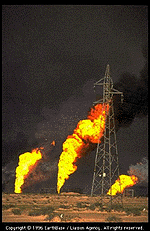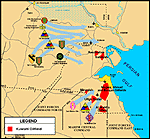
Oil Well Fires Video
In response to the Iraqi occupation of Kuwait, nearly 700,000 US troops were deployed during the Gulf War in 1990 and 1991. In addition to the risk of sustaining combat casualties, many of these troops were exposed to a variety of potentially toxic substances from a variety of sources. The most visible sources were the hundreds of oil wells that burned out of control over period of about nine months.
Beginning in January and continuing into late February 1991, Iraqi forces deliberately set fire to over 600 Kuwaiti oil wells, creating huge columns of smoke. The destruction of Kuwait’s oil fields did not come as a complete surprise to Coalition forces. By late 1990, intelligence and other sources indicated that Iraq would implement a "scorched earth" policy towards Kuwait’s oil infrastructure, should Iraqi forces face the threat of forced ejection from Kuwait. As the air war, and the simultaneous onset of the systematic destruction of the oil fields began, various Coalition commands began to disseminate information regarding the hazards associated with massive oil well destruction. Command level guidance was issued warning commanders and troops of the likelihood of oil fires, as well as outlining precautions to limit exposure to contaminants found in the oil fire smoke. The map in Figure 1 shows a portion of the US major command movement during the offensive ground campaign and shows the relative location of those US units that came the closest to Kuwait’s major oil fields.

Figure
1: Troop Movement/Oil Field Relational Map
In response to the widespread destruction of the Kuwaiti oil infrastructure, a huge fire fighting effort was organized. A number of teams from the US and around the world were organized to extinguish 605 burning wells and cap an additional 150 damaged wells. While some observers and experts predicted that this effort would take between 2 and 3 years to complete, the wells were brought under control in 9 months of rapid, intensive, and innovative around-the-clock work. The events surrounding the fire fighting efforts in Kuwait are discussed in Tab C.
At the time of the destruction, the medical and environmental community feared that exposure to the fires would result in catastrophic acute and chronic health effects. However, the high combustion efficiency of the fires, the nature and amount of contaminants in the smoke, the lofting effect created by solar heating, and the local wind and weather conditions combined to reduce the impact of the fires on military and civilian populations.
Results of air monitoring studies and a review of records of reported adverse health effects did not reveal a widespread short-term problem, but the possibility remained that smoke exposures could cause diseases in the future. Long-term health effects from exposure to air pollutants are determined primarily by the degree to which an individual is exposed. This assessment considers not only the concentration of a pollutant, but also the length of time an individual is exposed. Fortunately, the time period in which military and civilian populations were subjected to pollution from the fires was relatively short. Nevertheless, reports of various short-term, adverse health symptoms occurred during the war, which may have been related to exposures to oil fire smoke.
Some Desert Storm veterans have expressed concerns over health problems that they, in part, attribute to their exposures to oil smoke. Some of these problems have involved an exacerbation of an existing respiratory condition (e.g., asthma, bronchitis). In addition to these respiratory complaints some veterans reported short-term symptoms including: coughing, black mucous in nasal discharge, eye and throat irritation, and the onset of skin rashes and shortness of breath.
"There were... days when the smoke [plumes] 'hugged' the ground and turned the sunlit, bright day into a dark of night. [We] traveled the 'coastal highway,' from Kuwait City down to Saudi Arabia... and the petroleum-thickened air was so impregnated that we choked on oil while breathing through our doubled-up scarves... we were forced to stop and clear the raw petroleum off vehicle windshields and our goggles constantly. At [times] on the highway the... air was so thick our vehicle headlights could not penetrate the air further than 10-15 feet, and Marine escorts were needed to walk... ahead of the vehicles to keep us on the highway."[3] Gulf War Veteran
Under the more typical atmospheric conditions that occurred during the period, the levels of most pollutants measured in the Gulf were below US ambient and occupational standards, and were much lower than those that are known or expected to cause short- or long-term health effects.
There were, however, exceptions to these general conditions and findings. The first was the high level of particulate matter that was measured in the region that exceeded US EPA ambient and occupational standards. The second was the short-term, intense exposures to oil fire fall-out and debris experienced by some troops. An examination of the chronic health effects associated with these exposure scenarios is critical to the overall assessment of potential adverse health effects.
The levels of particulate matter (particularly in the respirable size range) observed in the region were high and had the potential of causing short-term adverse health effects. Particle size analyses conducted on air samples collected during the fires indicated that there was a significant mass of particles in the respirable range (i.e., less than 10 micrometers in diameter). However, the high particulate matter levels were not merely the result of the oil fires, but largely the result of natural background conditions. The high background level of particulate matter in the region has been associated with an allergic response in civilian populations. Hospital studies indicate that approximately 18% of the civilian population in Kuwait suffer from some respiratory complaint, primarily asthma, compared to roughly 6% in the US.
Pre-war monitoring data indicate that regional background particulate matter levels are among the highest in the world and originate from both natural and anthropogenic (i.e., man-made) sources. This is due primarily to re-suspension of particulate matter and severe, recurring sandstorms. The fundamental question surrounding this issue, therefore, is whether the exposure to the high levels of particulate matter, even for periods of rather short duration, has the potential for causing long-term health impacts in US troops deployed to the Persian Gulf? Results of a literature review on Gulf War illnesses conducted by the RAND Corporation, performed concurrent with this investigation, were inconclusive with regard to the long-term effects from this exposure. Several studies have been planned or are in progress to examine these health effects and characterize the risks associated with such exposures. These studies are being conducted by federally funded organizations and are discussed in greater detail in Section V of this report.
Second, this Environmental Exposure Report recognizes that some veterans were, on occasion, subjected to short-term exposures where they were literally covered with fall-out from the oil well fires. These exposure incidents, while intense, were generally short in duration and involved exposure to smoke, oil, soot (carbon particles), and other by-products of combustion from oil fires. Medical studies indicate that no significant acute medical problems have been identified with skin contact with crude oil. However, crude oil may be mildly irritating, particularly in contact with the eyes, to some sensitive populations. Furthermore, the volatile organic compound fraction of crude oil is an inhalation hazard. In very high concentrations these compounds may cause depression of the central nervous system and lead to other symptoms. Available monitoring data, however, indicate that levels were too low to result in adverse short-term health effects.
The long-term health effects associated with these short-term exposures are less clear. Here also there is a lack of information in the literature that evaluates this somewhat unique type of short-term intense exposure. There is, however, clinical and anecdotal information available on a cadre of firefighters whose exposures were more severe in terms of frequency and duration. This information indicates that the firefighters who went to Kuwait had, on average, 10 years experience in fighting similar fires, did not use respiratory protection equipment, did not exhibit the symptoms commonly reported by Gulf War veterans, and have not experienced any long-term health effects.
Several self-report surveys (i.e., 11th Armored Cavalry Regiment, US Navy, Department of Defense Comprehensive Clinical Evaluation Program, and the Iowa Persian Gulf Study), conducted on US troops during and shortly after the oil fires, indicated increases in reported symptoms and an association between the prevalence of complaints and proximity to the oil fires. There are no data from medical studies, however, to indicate that those symptoms were indicators of disease or that the symptoms were causally associated with proximity to the oil fires.
The results of two troop health risk assessments were incorporated into this investigation. The intent of including these results is to provide, in part, a check on the findings of the health effects literature review. That is, the findings of the health effects literature review and the health risk assessment ideally should complement each other in terms of identifying potential health concerns.
The risk assessment studies conducted by the US Army Center for Health Promotion and Preventive Medicine and its predecessor the US Army Environmental Hygiene Agency, support the general findings of the RAND report. Risk levels, based on calculated and measured contaminant concentrations, were estimated for each troop unit deployed to the Persian Gulf and compared to US EPA exposure criteria to protect the general public. Risk, that is, the potential for an adverse health effect to occur in exposed populations, is expressed for cancer and non-cancer (i.e., damage to the cardio-pulmonary, renal, neurological, and reproductive systems) causing agents. Results indicate that, for all troop units deployed to the Persian Gulf, the potential for excess cancers and non-cancers to occur was below acceptable risk levels recommended by the US EPA. That is, the levels were below the range in which the US EPA expects the onset of disease to typically occur in a normal population.
Collectively, the results of the health effects literature review and risk assessment studies suggest that, with the exception of particulate matter, the concentrations of contaminants were at levels below those that are known to cause short- or long-term health effects. And therefore, except for the possibility that some pre-existing respiratory conditions may be exacerbated, one would not expect exposures to the levels of contaminants observed (other than particulate matter) to result in long term health affects. Further investigations, however, are necessary to fully assess the long-term health affects associated with exposures to particulate matter in the 10 micron or less (PM10) size range.
Further investigations are also necessary to examine the synergistic affect of multiple contaminants. For example, DoD civilian and military personnel were likely exposed to a number of health stressors making it possible that any adverse health effects could have resulted from a combination of stressors rather than a single one acting alone. A possible combination could include exposure to sand and dust as well as to the contaminants contained in smoke and the hydrocarbon mix of partially combusted oil. Personnel with susceptible pulmonary systems could have experienced some aggravation that sensitized them to other irritants and/or chemical agents. However, assessing all the possible exposure combinations that could have occurred during US troop deployment during the Gulf War is beyond the scope of this current investigation.
The investigation methodology followed to develop this report is discussed in Section II. Methodology. Subsequent sections of this report will examine relevant issues related to oil fires and include:
A description of the background conditions surrounding the geography, climate, and demography of the region, and a general discussion of the Kuwait oil industry are presented in Tabs D-G.
| First Page | Prev Page | Next Page |